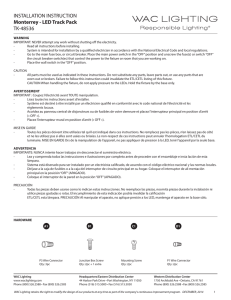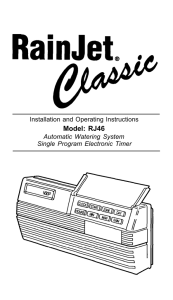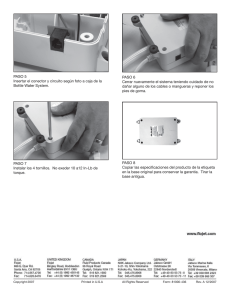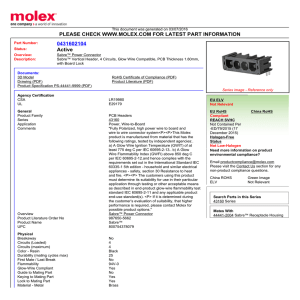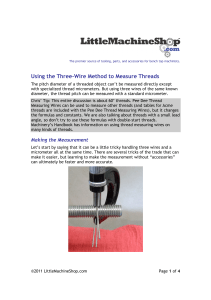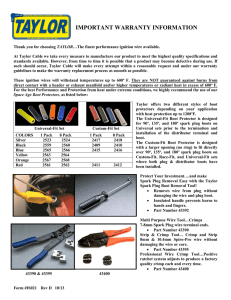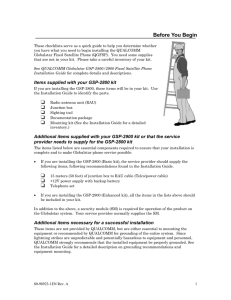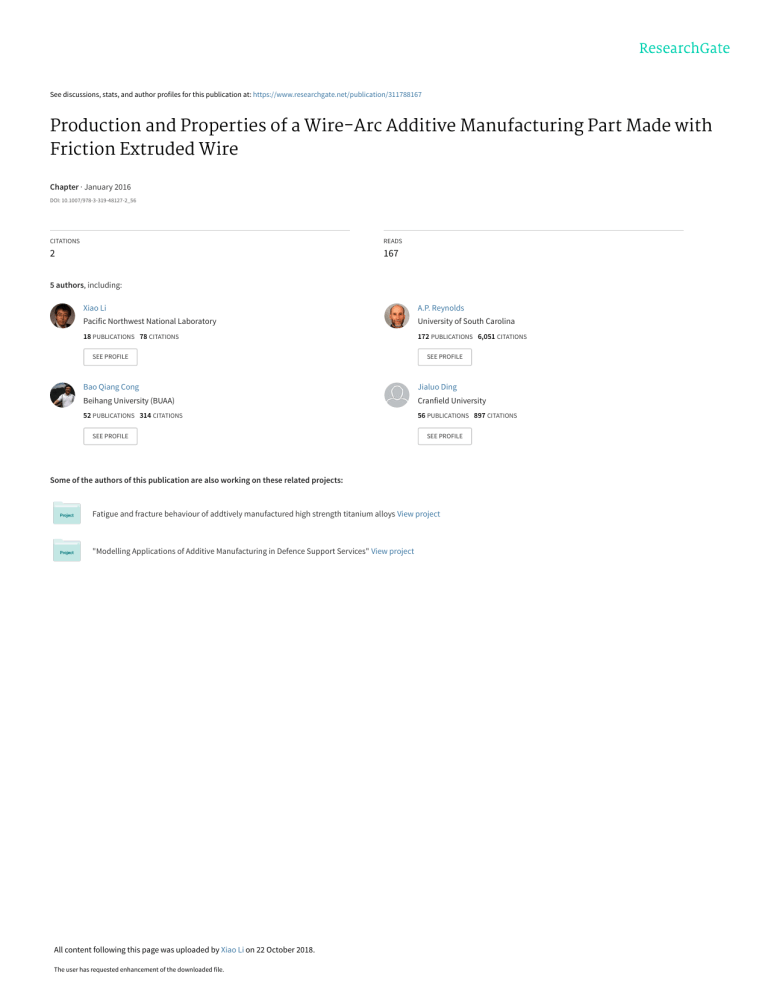
See discussions, stats, and author profiles for this publication at: https://www.researchgate.net/publication/311788167 Production and Properties of a Wire-Arc Additive Manufacturing Part Made with Friction Extruded Wire Chapter · January 2016 DOI: 10.1007/978-3-319-48127-2_56 CITATIONS READS 2 167 5 authors, including: Xiao Li A.P. Reynolds Pacific Northwest National Laboratory University of South Carolina 18 PUBLICATIONS 78 CITATIONS 172 PUBLICATIONS 6,051 CITATIONS SEE PROFILE SEE PROFILE Bao Qiang Cong Jialuo Ding Beihang University (BUAA) Cranfield University 52 PUBLICATIONS 314 CITATIONS 56 PUBLICATIONS 897 CITATIONS SEE PROFILE SEE PROFILE Some of the authors of this publication are also working on these related projects: Fatigue and fracture behaviour of addtively manufactured high strength titanium alloys View project "Modelling Applications of Additive Manufacturing in Defence Support Services" View project All content following this page was uploaded by Xiao Li on 22 October 2018. The user has requested enhancement of the downloaded file. PRODUCTION AND PROPERTIES OF A WIRE-ARC ADDITIVE MANUFACTURING PART MADE WITH FRICTION EXTRUDED WIRE Xiao Li1, A. P. Reynolds1, Cong Baoqiang2 3, Ding Jialuo2, S. Williams2 1 University of South Carolina, 300 Main St.; Columbia, SC 29205, USA Welding Engineering Research Centre, Cranfield University, Cranfield MK43 0AL, UK 3 School of Mechanical Engineering and Automation, Beihang University, Beijing 100191, China 2 Keywords: wire-arc additive manufacturing, friction extrusion, aluminum alloy Abstract Wire arc additive manufacturing (WAAM) is a flexible and high deposition rate technique for production of a wide range of components. Limited available composition of feedstock (wires) inhibits experimentation aimed at production of high strength parts, particularly for aluminum alloys. In this work, alloy 6061 wires were produced by friction extrusion and subsequently used as the feedstock in a Gas Tungsten Arc additive process. Deposits as thick as 15 mm were evaluated in terms of microstructure, defect content, and strength (via sub-scale tensile testing). Strength and hardness were evaluated both before and after post build aging treatments. Introduction Additive manufacturing is a potential route to improve performance and lower cost through reduced part count and improved material utilization. As a promising metal-based additive manufacturing method, WAAM combines an electric arc heating source with a wire feeding system [1]. It is of particular interest due to its relatively high deposition rate and efficiency of material usage [2]. In WAAM process, “weld” beads are deposited layer by layer to build 3D components. Various kinds of metals or alloys that are weldable can be used in the WAAM process, such as steels, Al alloys, Ti alloys, and Ni alloys. Since WAAM requires a wire feedstock, it follows that a technology which can produce high quality wire or fully consolidated bulk material from finely divided metals (e.g. machining chips or low-cost, powder precursors) would be a useful adjunct to both the integral machining process and many free form fabrication processes. Such a process would be economical and “green”: direct conversion of such waste without an intervening melting step should be relatively energy efficient. A manufacturing process, known as friction extrusion, was invented at the Welding Institute (Cambridge, UK) in the early 1990’s [3]. The friction extrusion process is related to simple extrusion processes with the primary difference being that the extrusion die rotates about the extrusion axis and the die is required to impart substantial deformation to the initially finely divided charge [4, 5]. In this study, friction extruded wires with different diameters were utilized as feedstock for a GTA based WAAM process. Straight walls up to 16mm high were built. Post build analyses including defect quantification, microstructure, hardness mapping, and tensile testing were performed. The feasibility, short comes, and possible ways of improvement of this technology are discussed. Experimental systems, parameter and procedures 1. Friction extrusion A C-frame milling machine with a hollow draw bar was employed for the friction extrusion process. The milling machine spindle was used to rotate the die while a hydraulic cylinder mounted on the knee was used to drive the billet chamber charge into the spindle. Hence, this was a force controlled extrusion somewhat analogous to forward extrusion with a rotating die. The rotation rate was set by gear selection and the extrusion pressure was determined by setting the hydraulic pressure on the ram by adjustment of a pressure regulator (the maximum hydraulic power supply pressure was 21 MPa). For this experiment a 25.0 mm diameter by 38.1 mm long Aluminum Alloy 6061 cylinder was used as the extrusion billet. The hollow drawbar enabled the extrusion of wires up to several meters long. The die hole size defines the diameter of extruded wire. 1mm and 2mm dies were used in this study. The die rotation speeds, extrusion forces and drawing dies used are shown in Table 1. Table 1 . Extrusion parameters and resulting wire lengths. Diameter of drawing Rotational speed Extrusion force Wire length die hole(mm) (RPM) (kN) (m) 1.0 300 106.8 1.36 1.0 400 106.8 2.70 1.0 400 106.8 2.60 2.0 300 106.8 4.30 2.0 300 106.8 5.30 No. 1 2 3 4 5 2. WAAM The experimental system is shown in Figure 1, which consists of a Fronius Magicwave 2000 power source, ABB robot, Fronius TIG torch with a diameter of 3.2mm W-2%Ce as electrode, and pure argon as shielding gas (BOC). The actual alternating arc current and voltage waveforms are represented in Figure 2, which shows that the positive polarity duration is 70% and that of negative is 30%. AA5083 plate with 6mm thickness was used as the substrate. Because 1mm wire is too thin for manual feeding, the three 1 mm diameter wires were wrapped together to form a single wire. The 2 mm wires were fed individually. All wires were cleaned by degreasing with acetone, cleaning with sandpaper (240 grits) and drying. All builds were produced by manually feeding the wire. Figure 1 AC-TIG experimental system for wire and arc additive manufacturing Figure 2 Actual arc current and voltage waveforms Builds were made w ith constant argon shielding gas flow rate of 15L/min, arc length of approximately 5mm, an electrode tip angle of 60°, and travel speed of 0.21m/min. Each layer was approximately 100mm long and 1 mm high. Arc current is varied with the increase of deposition layer number in accord with previous experience. 3. Post build analysis The WAAM parts were transversely cut, ground and polished. Void content was assessed on as polished specimens while Keller’s etchant (190ml water, 2ml HF, 3ml HCl, and 5ml HNO3) was used to elucidate the grain structure. Grain size was measured along the vertical direction of the build by using the mean linear intercept (MLI) method [7]. Next, the Vickers hardness along a central vertical line was measured on the transverse crosssection. Tensile bars were sliced as shown in Figure 3. A sub-scale tension tester and digital image correlation were used to obtain stress strain curves for the different layers. In addition to testing the material in the as built condition, a standard 6061-T6 aging treatment was applied (18 hours at 160°C). Vickers hardness and tensile tests were performed on aged material as described above. Figure 3 longitudinal tensile bars and sample positions Results 1. Products a. Friction extruded wires. Due to geometry of the experimental device, the extrusion direction is vertical. Therefore, the wire is twisted by the rotating die and then bent by gravity after exiting the draw bar. The wire sample No.3 is shown in Figure 4(1). Wires No.4 and No.5 are shown in Figure 4(2) and 4(3): some twisting of the wire is evident in the pictures. Metallography of the wires has shown that they are pore free and that the microstructure consists of fully recrystallized, equiaxed grains with a typical size of 10 m. (1) Wire No.3 (2)Wire No.4 (3)Wire No.5 Figure 4 (1) wire No.3 (2) wire No.4 (3) wire No.5 b. WAAM Builds. Multilayer deposition samples successfully made with the three AA6061 sample wires using the AC-TIG process are shown in Figure 5. The height of walls made with No.3, No.4 and No.5 are 3mm, 10mm and 16mm respectively. Figure 5 Profile of multilayer deposition walls made with friction extruded wires Due sub-optimal wire cleaning processes and issues related to waviness of the wires, inclusions geometric inconsistencies are intermittently observed on the build surface. The inclusions in a previous layer will influence the melting stability and quality of subsequently deposited layers and may result in porosity and other defects in the multilayer deposition. Inclusions and depressions which are indicated in Figure 6(2) and (3) are generated mainly due to imperfections in the wire. Twisting of the wire also results in somewhat inconsistent wire feed rate. 2. Analysis of WAAM builds a. Void content. As shown in Figure 7, there are many voids observed in the crosssections of the WAAM parts made with the friction extruded wire. For all three samples, the upper region contains more voids than bottom lower region: why this is so is not obvious but may be related to the arc model type [7] and changes in arc current with build height. The void number, total void area, average void size and void area faction at different heights are shown in Figure 8. The lower region contains a higher number of voids but total area and void fraction is relatively small. Middle and top region contains more, larger, voids: the largest void is over 50 m across. (1) WAAM part No.3 (2) WAAM part No.4 (3) WAAM part No.5 Figure 6 WAAM parts made with (1) wire No.3 (2) wire No.4 (3) wire No.5 13-16mm Crown 10-13mm 7-10mm 4-7mm 0-4mm Root Figure 7 Transverse cross-sections of WAAM parts b. Microstructure and Grain size. As shown in Figure 9, the microstructure of the builds is typical of arc weld deposited material. Grains were nearly equiaxed but slightly elongated in the vertical direction. On the boundary between the AA6061 walls and AA5083 substrate this vertical elongation is most obvious. The grain size of the highest build at crown, middle and root is presented in Figure 9. The grains are largest at the root and smallest near the crown. Figure 8 Distribution of voids on transverse cross-sections Figure 9 Microstructure and grain size on cross-section of WAAM sample No.5 c. Hardness. The Vickers hardness of No.4 and No.5 WAAM parts have been measured in two conditions: as-made and after a standard 6061-T6 heat-treatment. The hardness data are shown in Figure 10. Both of them give same trend of hardness along the vertical direction. From crown to root, the value increases first and reaches a peak of 105HV at 3mm from the top. Below three mm from the crown the hardness decreases to approximately 60 HV and remains stable. Below the boundary of the WAAM part and the 5083 substrate, the hardness of the substrate is higher than that of the wall. Comparing the result before and after heat treatment, the T6 heat-treatment generally provides a minor improvement on hardness but most regions remain far from the hardness of the standard 6061-T6 value 107HV. Figure 10 Vickers hardness on vertical central line of transverse cross-sections of part No.4 and No.5 Figure 11 Ultimate tensile stress and Vickers Hardness of WAAM sample No.5 d. Tensile strength. For both as-made and T6 conditions, longitudinal tensile specimens were machined from wall No.5. Digital image correlation was used for strain measurement on a subscale tensile testing frame. The ultimate tensile strength is presented together with hardness results in Figure 11. The strongest part of the wall has UTS over 320MPa at 3mm below the crown: this is similar to the UTS of standard 6061-T6. Comparing UTS values with the hardness results, indicates that they have similar trends with regard to position in the build. Discussion Feasibility of using friction extruded wire to produce WAAM parts has been demonstrated. The value of the friction extrusion process most likely lies in the ability to quickly and easily produce wires of various compositions in small batches. However, wire quality must be improved so that build defects can be minimized and so that automatic wire feeding can be utilized. In particular, it would be desirable to be able to use a GMA process. Improved wire handling processes to ensure cleanliness is one readily improved aspect. In order to eliminate the twisting inherent in friction extruded wire, it may be necessary to perform one or two drawing steps after extrusion. Done properly, this would improve wire geometry and surface finish. Once the mechanics of the wire production process are improved, it will be simple to produce small batches of varying composition for testing in WAAM processes. This will be a valuable adjunct to WAAM since optimum wire compositions for high strength aluminum alloy AM builds are not known and high strength aluminum alloy wires are not readily available. The maximum hardness and tensile strength observed in the WAAM product are very close to the values for AA6061 base metal. This indicates that high quality AA6061 products can be made by WAAM with friction extruded wire if certain favorable conditions are satisfied: it also may indicate that even higher strength alloys could be used. The defects (voids) in the WAAM parts may be caused by both poor surface condition of the wire and un-optimized thermal management from the standpoint of the actual deposition process. The matched trends of hardness and tensile strength with build height are very likely to be related to thermal history. Therefore, proper arc current and thermal management could be introduced to optimize the quality of AA6061 WAAM parts in following aspects: (1) minimization of defects, (2) improved uniformity of strength and hardness through the build. References 1. J. Ding, ‘‘Thermo-mechanical Analysis of Wire and Arc Additive Manufacturing Process’’, (Ph.D. dissertation, Cranfield University, 2012) 2. W. Syed, A. J. Pinkerton, and L. Li. ‘‘A comparative study of wire feeding and powder feeding in direct diode laser deposition for rapid prototyping,’’ Applied surface science 247.1 (2005): 268-276. 3. W. Thomas, et al.: International Patent Application No.PCT/GB92/02203 and GB Patent Application, 1991, No. 9125978.9. 4. W. Tang and A. P. Reynolds. ‘‘Production of wire via friction extrusion of aluminum alloy machining chips,’’ Journal of Materials Processing Technology 210.15 (2010): 2231-2237. 5. X. Li, W. Tang, and A. P. Reynolds. ‘‘Material Flow and Texture in Friction Extruded Wire,’’ Friction Stir Welding and Processing VII (2013): 339-347. 6. X. Li, W. Tang, and A. P. Reynolds. ‘‘Visualization of Material Flow in Friction Extrusion,’’ ICAA13: 13th International Conference on Aluminum Alloys. John Wiley & Sons, Inc. 7. ASTM Standard E112-96, Standard Test Methods for Determining Average Grain Size, 3 2004. 8. View publication stats B. Cong, J. Ding and S. Williams. ‘‘Effect of arc mode in cold metal transfer process on porosity of additively manufactured Al-6.3% Cu alloy’’. The International Journal of Advanced Manufacturing Technology (2014), 1-14.
